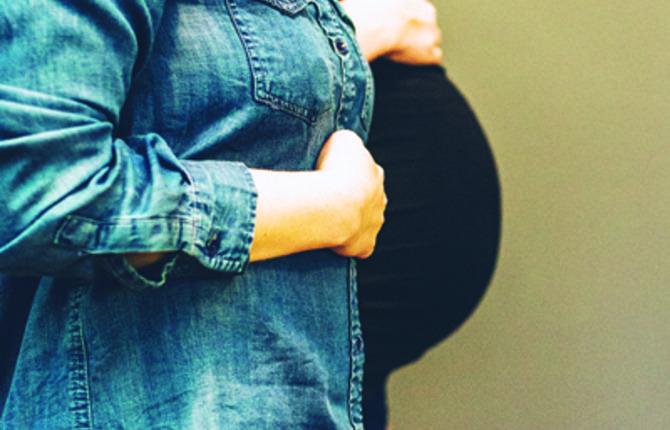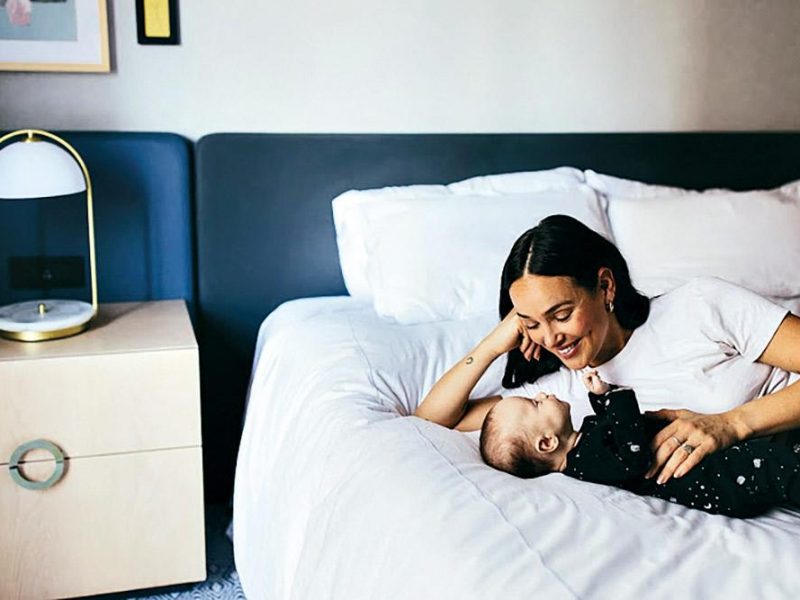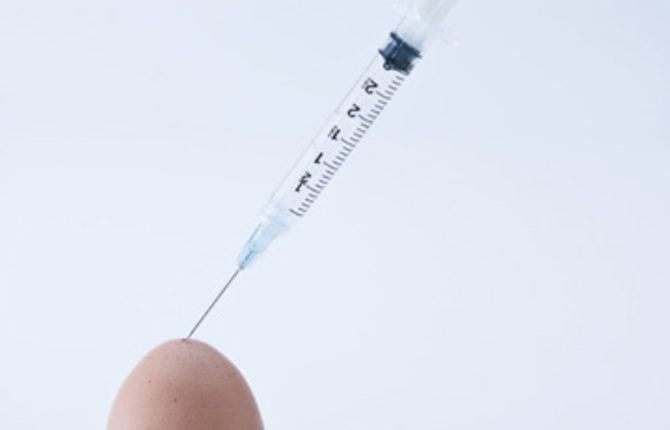
S is for surrogacy
By Christine Davis
Surrogacy. It’s like the scarlet letter in the parenting world despite the fact that one in six Canadian couples experience some form of infertility and is often a last resort for those who want to have biological children.
For the Andersons, a GTHA couple who tried unsuccessfully to get pregnant for seven years, surrogacy was pitched as an option they hadn’t even considered.
Ready to look into adoption following years of infertility treatment, failed in vitro fertilizations (IVF) and running out of options, it was the couple’s second fertility doctor who told them they needed to find someone to carry their biological baby.
Mr. Anderson, a self-described introvert, had an immediate “yeah right” reaction, saying he couldn’t ask anyone to do that for them. The doctor also suggested putting a call out to friends and family or even on Facebook, another idea he balked at. “I wanted to say ‘you have no idea who you’re talking to’. That’s not an option. It’s not happening.”
And yet, that’s exactly how the couple found the woman who would carry their son.
“Once we left the clinic we started thinking this is what we need to do,” says Mrs. Anderson. “But we also had a scheduled IVF and had no idea how to find someone, what that process would be.” The couple started researching, much as they’d done through their entire infertility journey, not knowing how to find someone and discussing it only with their closest friends and family.
It was one of those friends who, one morning, happened to tag Mrs. Anderson in a Facebook post a mutual friend had shared about surrogacy and her desire to be a surrogate. She immediately sent the woman who posted, a former classmate from college called Natasha, a private message suggesting she look into the process if she was really interested and also shared her story and search for a surrogate.
Just reaching out
“I just wanted to get the point across to her how great it is and important for people in our situation where it was our only option and that if there are people like her then we can actually have a family. I wanted her to know that people like her give us hope and suggested she look into it and see if she would qualify to be a surrogate.”
Despite the fact that Mrs. Anderson didn’t suggest Natasha become her surrogate, that’s exactly what she offered to do only hours later.
Natasha explains that she’s always wanted to be a surrogate, an idea she came up with as a pre-teen. But before having her own children was something she was open to doing only for a small handful of people, best friends and maybe her sister. “As I got older that handful grew bigger – from best friends and sisters to cousins.” Then, just before she found out about the Andersons a co-worker announced she was becoming a surrogate for a couple in Newfoundland. “I’d never met anyone who had done it before. I lost my mind, asked a million questions.”
After receiving Mrs. Anderson’s private message Natasha immediately called her husband and asked if he was okay with her becoming the Andersons’ surrogate. He was just stepping into a meeting, but called her back right after saying if it was something she really wanted to do then she should go ahead and do it.
By 5 p.m. that same day, Natasha told the Andersons she wanted to be their surrogate and from that point pushed forward even though the Andersons didn’t want her to rush through or take things lightly.
“I don’t think either of us knew 100 per cent what we were getting into,” Natasha says of her and her husband. “I wanted to do it in my heart but I didn’t know the logistics. I didn’t know it would be two years of my life.”
Meanwhile the Andersons didn’t know that finding Natasha would be the so-called “easy” part. The next steps included a series of long waits and what the Andersons call “jumping through hoops just to get to transfer day.”
There was a long wait for a referral for Natasha to see the doctor at the Anderson’s clinic, medical screenings, mandatory counselling for the Andersons, Natasha and her husband and the initiation of the legal portion of the surrogacy, for which the Andersons dealt with Canada’s premier fertility lawyer, Sara Cohen, who drew up the initial contract.
Uncomfortable conversations
“There were lots of uncomfortable things we had to talk about,” says Mr. Anderson, followed by Mrs. Anderson who explained that much of the process revolved around deciding “who has the say. It’s her body, but our baby.” Issues such as how and where the baby would be born were included, as well as what expenses the Andersons would cover towards the pregnancy.
While it’s illegal in Canada to pay a surrogate for carrying a baby, many of her pregnancy-related expenses can be covered, such as chiropractic care, supplements and even clothing – all of which can be capped by the biological parents, but must be outlined in the legal agreement.
The Andersons’ agreement took weeks of back and forth and opened their minds to the fact that they were really putting their baby in another person’s belly, a process that confirmed for Mrs. Anderson that if their surrogate was a stranger “we couldn’t do it.”
Part of that feeling, despite the lack of a personal connection to the surrogate, surrounds the fact that up until recently, in Canada, any person giving birth is automatically the mother. However, with the passing of Bill 28, the All Families Are Equal Act, it’s been determined that this isn’t always the case, but must be outlined legally. The introduction of this Act made the legal process substantially easier – and less costly – for the Andersons, who say they spent upwards of $50,000 on the surrogacy process. “This form makes it easier to outline who the parents are, but we were lucky to be comfortable with Natasha, we could trust her, otherwise it would have been way more stressful.”
Developing a friendship
Mrs. Anderson goes on to explain that despite going to college together, she and Natasha weren’t close friends and hadn’t kept in close contact in the 10 years following their graduation. “We had a sort of connection. We didn’t bond and become friends really quickly. We just started the process and the friendship grew along the way because of what we’ve been through. We invited her on our journey and we’ve dealt with everything together.”
That included a missed transfer because Natasha’s body wasn’t operating the way the doctor would have expected it to, as well as a failed transfer – a chemical pregnancy that Natasha totally took to heart.
“When the transfer failed I cried for two days straight,” she confesses. Not one to “ever separate my emotions from anything,” Natasha was unprepared for her feelings of failure, despite counselling from the clinic and complete support from her family. “I’ve had my own miscarriage and it was devastating but to try and fail when you’ve got someone else’s emotions is very hard.”
The Andersons considered the second transfer to be “our last way for us to have a family.” They decided to use their best egg, despite the fact that Natasha’s body still wasn’t responding exactly as the doctor had hoped. That A+ egg, or “the awesome one,” as Mr. Anderson calls it “is going to be our son.”
The Andersons “almost went broke on pregnancy tests,” they joke, describing how many tests they had Natasha take in July 2016 – almost a year after first connecting with her.
Natasha was the first to confirm the pregnancy with the clinic. “I could hear in the nurses’ voice how genuinely happy she was for them.” She then couldn’t wait to confirm with the Andersons “I was so happy for them,” and she also called her mom and husband with the good news.
Letting success sink in
“For me the biggest surprise was after seven years of trying and never having anything going right. My body and mind wouldn’t accept things were going right. I was so used to failure,” says Mrs. Anderson. “We wouldn’t let ourselves believe it was happening.”
Mr. Anderson said it wasn’t until Natasha was 20 weeks along in the pregnancy before he let his guard down.
Since then, Natasha describes every milestone in the pregnancy as “that much more exciting,” because “everything is compounded by three.”
But the Andersons say it hasn’t all been smooth sailing. Their excitement for the baby has been hindered by some lack of support and decorum from people in their lives. They’ve heard hurtful things – unintentional though they may be – from everyone from family to customer service people at baby supply stores. Though they chalk much of it up to ignorance about surrogacy they’ve had to deal with countless situations in which there was a lack of sensitivity to what they’ve gone through with some people even going so far as to question if they were truly the biological parents.
It hurts, but Mr. Anderson says; “we choose to focus on the end result. We’ll have a family and this is how we had to do it. There’s no point in thinking about it any other way.”
Despite the fact that Natasha says this pregnancy has been different from those of her boys’, aged 5 and 7, she believes it’s all been worth it.
“When you start it you think there’s two people who want a baby and you want to help them. As you get further you see all the ripples from those two people to everyone affected.”
Someone else’s baby
From the start Natasha was adamant that she would be fine ‘giving up a baby’. As the due date nears, she feels the same way. “It’s still not my baby. He belongs to someone else. He will always have a place in my heart but he’s theirs and that’s probably going to be the best part.” She’s the one who insisted both of the Andersons be in the birthing room because she believes it’s “important they see him come into the world and be the first ones to hold him. It will be fantastic.”
Mrs. Anderson plans on being the first one to hold her son while Mr. Anderson cuts the cord in a move she describes as “very symbolic.”
The Andersons and Natasha are proud of the relationship they’ve built between themselves and their extend families. The baby will know about his surrogate and they even plan on taking family vacations together. “She’s extended family now,” Mrs. Anderson says of the woman who has helped her have a family.
“I can feel like I did this,” Natasha says, I built a family and these are all the people that are affected by it.”
Mr. Anderson says that despite the up-hill climb to have a baby “later on in life we can look back and say we did everything we could so we don’t have any regrets.”
Their advice, as they anticipate the arrival of their son, is that for parents who need to go the surrogacy route is to talk about it. “We didn’t like to talk to people about it, but I actually think for surrogacy specifically it’s really important,” Mrs. Anderson says. “Now that we talk about it,” the couple is open with everyone, including their Facebook networks about the surrogacy, “almost half of the people we know have known a surrogate or needed a surrogate.”
She goes on to say she feels like it’s often “hush, hush,” a taboo subject that Mr. Anderson says simply isn’t understood by most people.
While Natasha says she would likely go back to that initial small handful of close friends and family if she were to ever be a surrogate again, she says it’s a process she hopes others will consider and look into. “There are many deserving families out there that only need that one special person to be in their lives to be able to give this to them and as tough as pregnancy is it’s so much more rewarding. It will be the best thing you will do in your life.”
Photo by Kayla Somers, Kayla Somers Photography, Carleton Place ON







